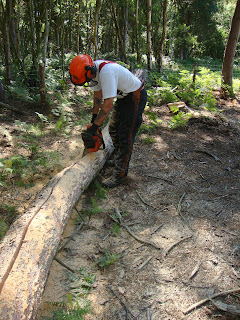Whale Bone Arch was a working title for this feature which described it very well, even though it has nothing to do with whale bones. There were several particularly curved pine trees growing yards from the entrance. I guess this curved trunk is caused by the tree moving to reach more day light?
John from Kent Wildlife Trust identified which was the best one to use and felled it with a chain saw.
 |
| the chosen tree |
 |
he's done this before
I can tell |
After quick work by John the tree was down, and I had not even managed to video it....
The branches wiped off quick and in no time
the tree is ready for the next stage
The next stage is a tricky cut running along the whole length of the tree.
By leaving the two ends still joined and cutting the middle, then doing the ends last. It is essential to get a smooth cut as this will form the new face

Neither of us could really tell how this was going to look or what was the best way to install this thing and it lay on the floor for a couple of weeks waiting to be installed near the entrance. I walked past it several times with Cosmo, looking at it wondering if it would be easier and to install it with the bits I had imagined being in the ground, sticking up in the air. This would avoid having to cut a difficult mitre join during the installation.
 |
| this end in the ground |
 |
| and this end in the air |
John had been thinking exactly the same thing as installation was hard enough already.
 |
| view from the trail |
 |
| view from the main path |
So, the feature is very firmly in and stable, while the surounding birch trees wil be cut back or removed to clear the view. How to decorate it, and what be appropriate is the next decision? This will wait a while as other features are going in and have priority. We can't call it the whale bone arch anymore as it does not look like one so much anymore and a bottle kiln is urban not woodland, so again its just sitting at the back of my mind. A spiders web with concentric rings and a circular hole in the centre is where my thoughts for it are right now!
What is very odd, is that from the main path you can't even see it, yet it must be approching 25 feet tall. The bark makes it blend in with its surroundings. A threshold you dont realise your crossing or an invisable door. Approach it from the other side and it is much more visable. I expect it will transform again when the surounding trees are trimmed back or possibly removed altogether.
 |
| the installed arch. |





























